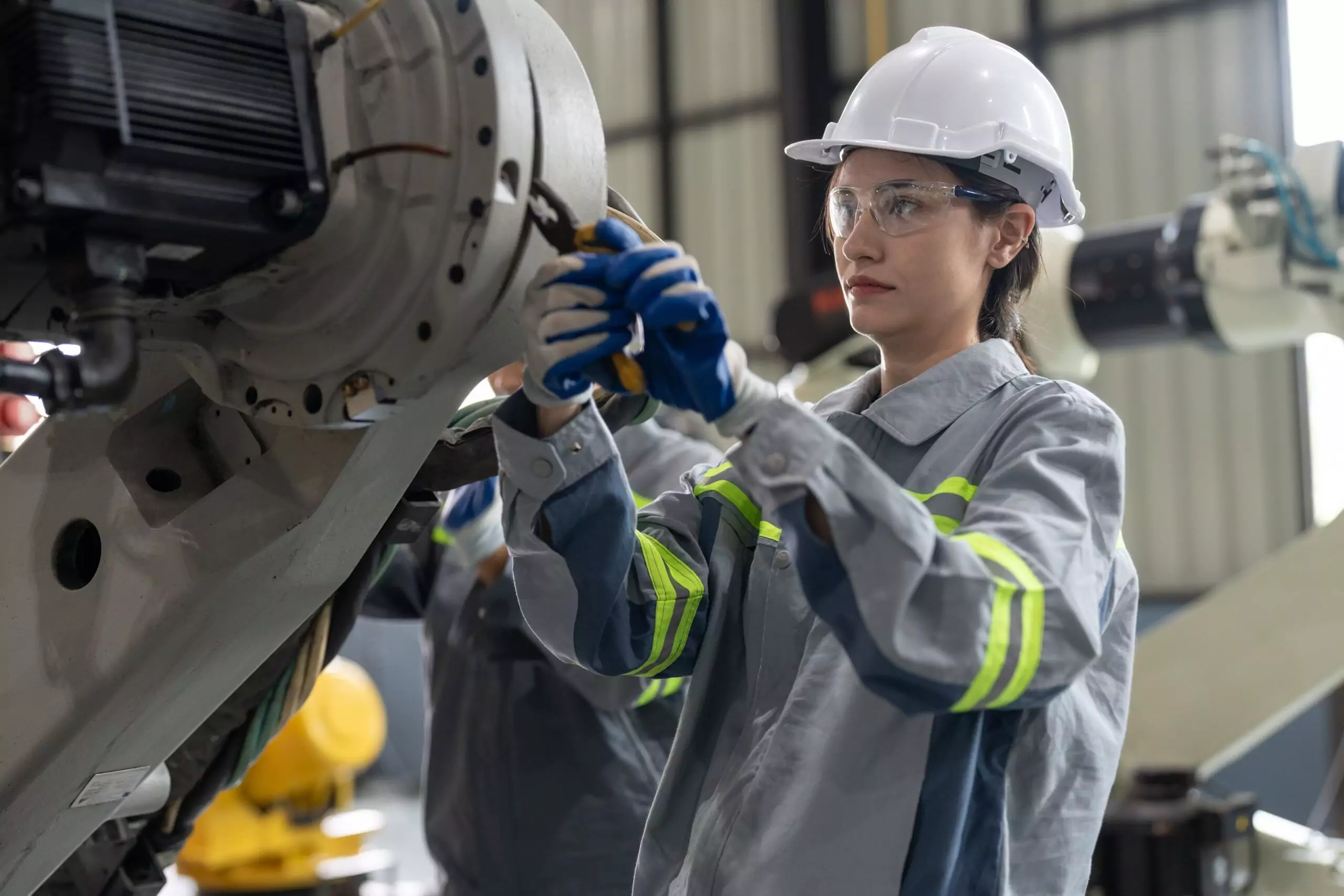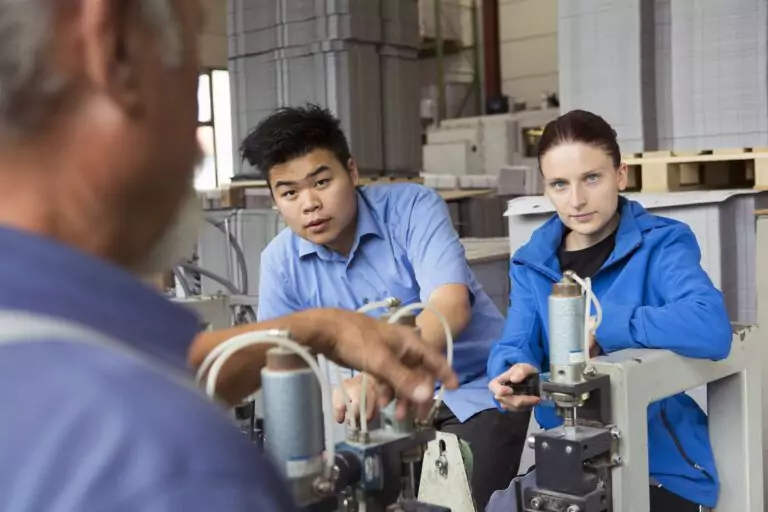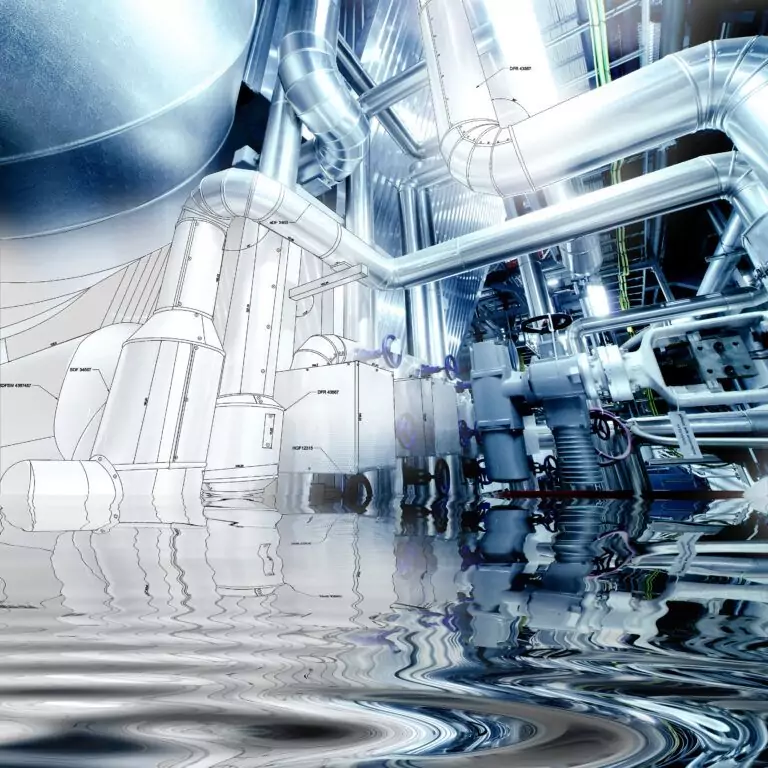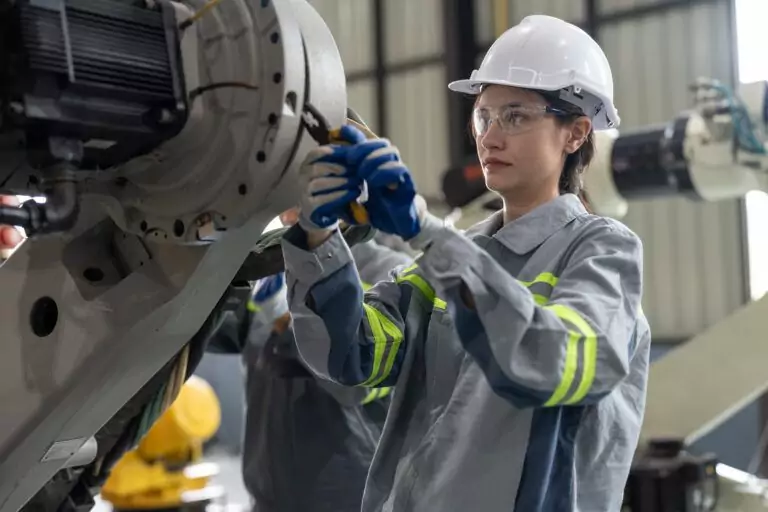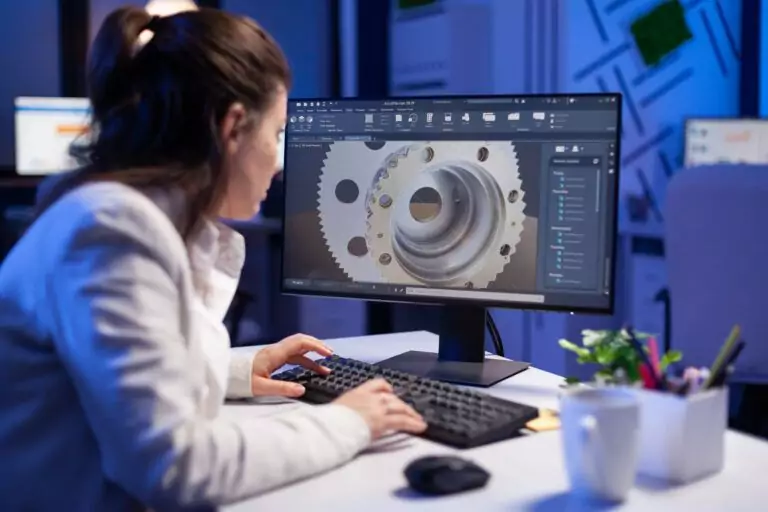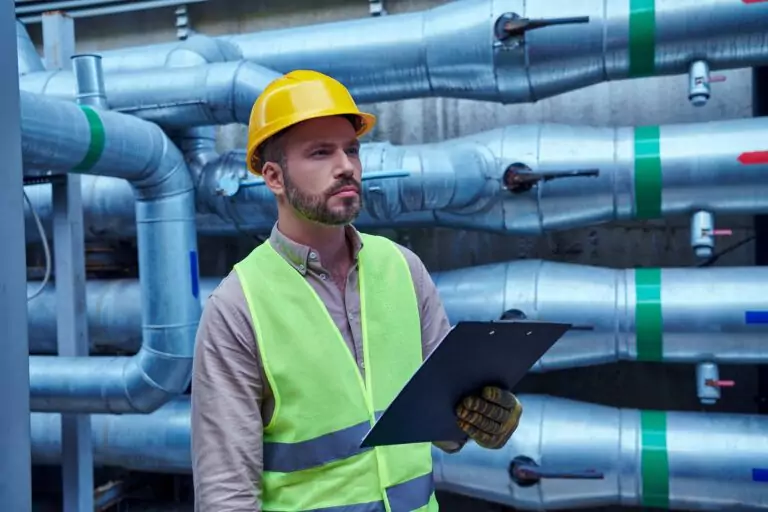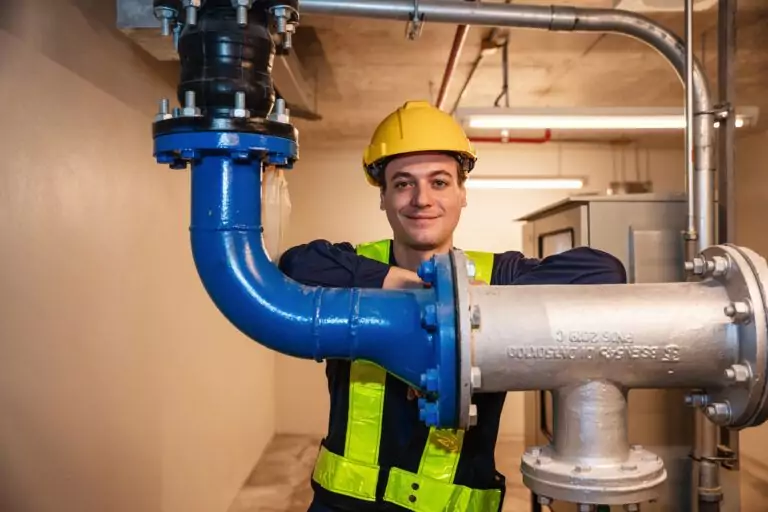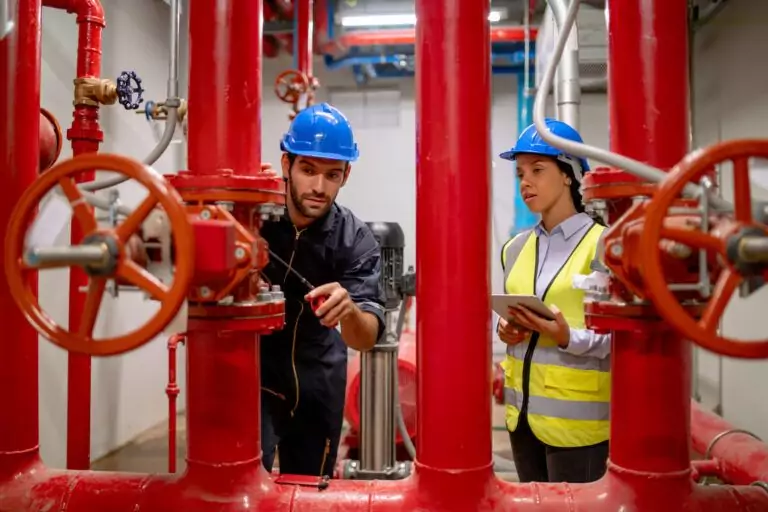Most academic explanations of mechanical engineering education start with theoretical thermodynamics principles, materials science fundamentals, and heat transfer equations. Useful for passing exams. Useless for understanding what you’ll actually do at work.
The real career question is, what does a practising mechanical engineer’s typical workday actually look like in industrial settings? What problems get solved? What deliverables get created? Which teams collaborate on projects?
The work looks nothing like textbook problems. Engineers aren’t calculating the theoretical efficiency of ideal heat engines. They’re sizing actual heat exchangers for corrosive service. Selecting real pumps that need to run reliably for 20 years. Coordinating equipment layouts with piping, structural, and electrical teams.
This guide explains mechanical engineering jobs and what mechanical engineers do daily, from entry-level design responsibilities through senior technical leadership roles. You’ll learn how the work varies across owner organisations versus engineering contractors, how mechanical engineering applies to emerging energy sectors, what daily tasks look like at different career stages, and how modern digital tools change the profession.
Staying informed about current mechanical engineering job market trends and employment outlook across different sectors helps you make strategic decisions about specialisation and geographic location.
Disclaimer: Mechanical engineering responsibilities, required skills, typical salaries, and job market conditions vary significantly by industry sector, company size, geographic region, and experience level. Applicable codes, standards, and engineering practices also differ by jurisdiction. All information reflects 2025 industry conditions and should be verified with current sources and professionals in your target sector before making career or educational decisions.
The Core Responsibilities That Define Mechanical Engineering Work
Professional mechanical engineers design, analyse, and specify mechanical systems and industrial equipment for petrochemical facilities, manufacturing plants, and energy production operations.
That’s the simplified summary. The actual work involves equipment selection, performance calculations, material specifications, code compliance verification, and technical documentation. These activities happen across every project phase from concept through operations.
Equipment Design and Component Selection for Industrial Applications
Mechanical engineers specify industrial pumps, gas compressors, shell-and-tube heat exchangers, ASME pressure vessels, storage tanks, and rotating machinery equipment for process facilities. Equipment is matched to process requirements while considering reliability, maintainability, and cost.
This equipment selection process isn’t simple catalogue shopping. Engineers analyse operating conditions. Calculate the required performance. Evaluate materials for temperature, pressure, and chemical compatibility. Compare vendor options. Make recommendations based on technical merit and lifecycle economics.
Equipment selection requires understanding mechanical principles plus practical considerations. That centrifugal pump might meet hydraulic requirements, but it creates maintenance headaches because repair parts take 16 weeks to deliver. These real-world constraints matter more than textbook optimisation.
The engineering work includes preparing detailed equipment datasheets that specify required performance parameters, construction materials, applicable design codes, factory testing requirements, and vendor documentation deliverables. These datasheets become the basis for procurement and vendor engineering.
Engineering Calculations That Verify System Performance and Safety
Mechanical engineers perform engineering calculations to verify proper equipment sizing, structural adequacy and stress analysis, thermal performance and efficiency, and safety factor compliance. Designs must meet functional requirements without failures.
Common engineering calculations include centrifugal pump head requirements, heat exchanger thermal duty, ASME pressure vessel wall thickness, piping flexibility stress analysis, and structural support loads. Engineering fundamentals are applied to specific design conditions with appropriate safety factors.
Modern practice relies on specialised software, but understanding the underlying principles remains essential. Software produces garbage with the wrong parameters. Results must make physical sense before using calculations for design decisions.
Documentation matters. Calculations become project records supporting design decisions. During operations, they help troubleshoot problems or evaluate modifications. Clear calculation packages with assumptions, inputs, methods, and results are essential.
Technical Specification Development and Standards Compliance
Mechanical engineers develop detailed technical specifications covering materials of construction, fabrication, welding methods, quality inspection requirements, factory testing procedures, and performance acceptance criteria. Sounds straightforward? The devil lives in these details.
Engineers apply industry design codes such as ASME Boiler and Pressure Vessel Code (BPVC), API (American Petroleum Institute) standards for rotating equipment, and ASHRAE standards for industrial HVAC systems. However, specific code requirements vary by jurisdiction, project type, and client specifications. Understanding which codes apply and how to implement requirements is fundamental mechanical engineering work.
Specifications also address client-specific standards. Owner organisations often have engineering standards based on operational experience. Generic industry practice is adapted to meet these project-specific requirements.
The work requires balancing competing priorities. Tighter specifications improve reliability but increase cost and schedule. Finding appropriate specification levels for project requirements and risk tolerance is an engineering judgment that develops with experience.
How Mechanical Engineers Work Within Integrated Project Teams
Mechanical engineering happens within multi-disciplinary teams. Constant coordination occurs with piping, structural, electrical, instrumentation, and process engineers.
Modern projects use integrated approaches where disciplines work concurrently rather than sequentially. Mechanical engineers participate in design coordination meetings, 3D model reviews, and interface resolution sessions. This collaborative environment produces better designs with fewer construction problems.
Piping and Equipment Layout Coordination
Mechanical and piping design engineers collaborate on industrial equipment arrangements and plant layout optimisation. Equipment nozzle locations, clearance requirements, and maintenance access needs are defined. Piping engineers route pipe considering those constraints.
The multi-discipline design coordination process is iterative and ongoing throughout detailed engineering. The initial equipment layout is modified based on piping routing challenges. Piping routes adjust when equipment placement changes. 3D models are reviewed together to identify conflicts before construction.
Good coordination prevents field problems. Equipment positioned without considering piping access creates construction delays and cost overruns. Anticipating these interfaces during design eliminates rework. This is where textbook knowledge meets reality.
Coordination also covers thermal expansion, support loads, and vibration considerations. Piping reactions affect equipment nozzle loading. Equipment vibration influences piping support requirements. These mechanical interactions require joint engineering between disciplines.
Multi-Discipline Interface Management
Mechanical engineers define static equipment loads, dynamic operating forces, and structural support requirements for foundation design. Structural engineers design foundations and support structures meeting those requirements.
Load data, including static weight, dynamic loads, seismic requirements, and thermal expansion forces, is provided to structural teams. Structural engineers use this information for foundation and support design, and they return drawings showing support locations and interfaces.
Process engineers establish functional operating requirements and performance criteria that mechanical equipment designs must satisfy. They define flow rates, temperatures, pressures, and fluid properties. Mechanical engineers translate these requirements into equipment specifications.
Electrical coordination covers motor specifications, electrical power requirements, and equipment motor control systems. Mechanical equipment needs are defined. Electrical engineers provide power and control systems. Missing any interface creates startup problems and operational difficulties.
Mechanical Engineering Across Different Industry Sectors
Mechanical engineering work varies significantly by industry. The fundamentals stay constant, but equipment types, design codes, and operational challenges differ.
Understanding sector-specific requirements matters when targeting particular industries. Petrochemical experience doesn’t automatically transfer to power generation. Mining applications differ from pharmaceutical manufacturing. Each sector has specialised knowledge requirements.
When transitioning between sectors or targeting specific industries, expect hiring managers to assess your knowledge through mechanical engineering interview questions focused on industry-specific applications and real-world problem-solving rather than just theoretical concepts.
Petrochemical and Refinery Mechanical Systems
Petrochemical processing facilities and oil refineries use complex mechanical systems and rotating equipment for hydrocarbon fluid processing operations. Engineers specify pumps for handling corrosive chemicals, compressors for high-pressure gas service, and heat exchangers for elevated-temperature applications.
Industrial equipment reliability and uptime performance are critical for continuous operations. Unplanned shutdowns can result in substantial financial losses. Designs emphasise continuous operation with appropriate redundancy, robust materials, and maintainable configurations. Equipment selection emphasises proven technology over cutting-edge designs.
The work requires understanding chemical compatibility, high-temperature metallurgy, corrosion mechanisms, and hazardous area classifications. Common industry standards include API specifications for rotating equipment, ASME codes for pressure equipment, and NFPA requirements for fire protection systems, with specific requirements varying by project and jurisdiction.
There was a compressor selection meeting where the client rejected the most efficient option because it used a seal system their maintenance team hadn’t worked with before. The “inferior” choice with familiar technology won. Operational reality trumps paper performance every time.
Oil and Gas Production and Processing Equipment
Oil and gas industry facilities include upstream wellhead production equipment, midstream gas processing plants and compression stations, and pipeline transmission infrastructure. Mechanical systems handle production fluids, separate gas from liquids, and compress gas for transport.
Equipment operates in harsh conditions. Remote locations. Extreme temperatures. Corrosive fluids. Designs emphasise reliability, robustness, and minimal maintenance requirements. Packaged systems are often specified to arrive site-tested and ready for operation.
Upstream mechanical engineers work with wellhead equipment, separators, heater treaters, and artificial lift systems. Midstream roles involve gas processing equipment, compression stations, and metering systems. Each segment has specialised equipment and knowledge requirements.
Renewable Energy and Carbon Capture Applications
Renewable energy system integration and carbon capture and storage (CCS) technologies represent rapidly growing mechanical engineering applications and career opportunities. These emerging technologies need engineers who understand both new processes and traditional mechanical design.
Carbon capture systems involve multi-stage gas compression, CO2 chemical separation, industrial refrigeration, and chemical processing equipment. Conventional mechanical engineering is applied to novel applications. Equipment types are familiar, but operating conditions and process requirements differ from traditional applications.
Wind energy facilities need mechanical engineers for turbine drivetrains, tower structures, and foundation designs. Solar thermal plants require heat exchangers, thermal storage systems, and steam generators. Green hydrogen production involves electrolysers, compression systems, storage vessels, and distribution infrastructure.
Daily Tasks and Project Work at Different Career Stages
What engineers actually do depends on their experience level. Entry-level engineers perform different work from senior technical experts.
Understanding career progression helps set realistic expectations. Major design decisions don’t happen on day one. But they happen eventually with developed competency and judgment.
Entry-Level Engineer Responsibilities and Learning Curve
Junior mechanical engineers support senior engineering staff on capital design projects and equipment selection activities. Work includes performing calculations, researching equipment options, preparing datasheets, reviewing vendor drawings, updating drawings and specifications.
Typical daily tasks include sizing shell-and-tube heat exchangers using HTRI software, calculating centrifugal pump NPSH and head requirements, preparing detailed equipment datasheets for procurement packages, organising vendor technical documentation submittals, and reviewing vendor submittal drawings for compliance with project specifications.
The work teaches fundamentals while contributing to projects. Industry codes, standard practices, calculation methods, and documentation requirements are all learned through practical application. Senior engineers review work, explain corrections, and gradually increase responsibility.
Coordination meetings teach how mechanical engineering integrates with other disciplines. Design reviews show how experienced engineers evaluate designs. This exposure accelerates learning beyond what textbooks can teach.
Building strong mechanical engineering portfolio examples that document your calculations, equipment selections, and project contributions becomes critical as you progress from entry-level to mid-level roles.
Mid-Level Engineer Project Leadership and Technical Decisions
After gaining several years of professional experience, engineers lead complete mechanical design packages with less senior oversight. Equipment selections, calculation approvals, discipline coordination, vendor interfacing, and junior engineer work reviews all happen at this level.
Typical mid-level responsibilities include leading mechanical design scope for process plant units, evaluating vendor equipment proposals and making technical recommendations, coordinating equipment plot layouts with piping and structural engineering teams, reviewing and approving vendor engineering documents, and supporting procurement activities during equipment shop fabrication.
Judgment develops through experience. Designs are seen working and failing. Practical implications of decisions become clear. Problems are anticipated before occurring. This experience-based knowledge distinguishes mid-level engineers from junior staff.
Client interaction increases. Design review meetings require explaining mechanical design decisions. Client technical questions need answers. Mechanical engineering is represented on project teams. Communication skills matter as much as technical ability.
Senior Engineer Design Review and Client Interface
Senior mechanical engineers perform independent design reviews, mentor junior engineering staff, interface directly with client organisations, and provide technical leadership on capital projects. Design quality is ensured, complex technical decisions are made, and difficult problems are resolved.
Calculations and designs from teams are reviewed, verifying technical adequacy. Assumptions are challenged, gaps are identified, and improvements are suggested. This oversight ensures deliverables meet project requirements and professional standards.
Client relationships become central. Project meetings are attended, mechanical design approaches are presented, client concerns are addressed, and feedback is incorporated into designs. Building client confidence in technical recommendations is essential.
Senior roles often involve less detailed design work and more strategic thinking. Design approaches are planned, resources are allocated, project risks are identified, and solutions are recommended to project leadership. The work shifts from individual technical execution toward team leadership and client relationship management.
Equipment Specialisations Within Mechanical Engineering
Many mechanical engineers develop specialised expertise in specific equipment types. Specialisation increases value and differentiates from general mechanical engineering backgrounds.
These specialisations develop through repeated project exposure. Several projects involving similar equipment build deep knowledge. Recognition as an expert for those applications follows.
Rotating Equipment Engineering for Pumps, Compressors, and Turbines
Rotating equipment specialists focus on centrifugal pumps, reciprocating and centrifugal compressors, steam and gas turbines, electric motors, and power generators. Expertise is developed in machinery selection, performance analysis, installation requirements, vibration diagnostics, and reliability improvement.
The specialised engineering work requires detailed technical knowledge of API (American Petroleum Institute) standards governing the design and installation of industrial rotating machinery. Bearing types, seal selections, coupling requirements, baseplate designs, and alignment procedures all must be understood. Coordination with vendors on custom machinery engineering happens regularly.
Large compressors and turbines represent significant capital investments. Getting selections right matters. Operating conditions are analysed, vendor proposals are evaluated, detailed engineering is reviewed, shop testing is witnessed, and field installation and commissioning are supported.
Static Equipment Including Pressure Vessels and Heat Exchangers
Static equipment design engineers specialise in ASME pressure vessels, shell-and-tube heat exchangers, atmospheric storage tanks, and pressurised storage systems. ASME pressure vessel codes, heat exchanger thermal design, and tank foundation requirements all must be mastered.
The work involves detailed stress analysis, material selection for process conditions, corrosion allowance determination, and inspection program development. Coordination happens with process engineers on thermal ratings, with structural engineers on support designs, and with quality assurance on fabrication inspection.
Heat exchanger design combines thermal analysis with mechanical design. Exchangers are sized for the required duty, tube configurations are selected, materials resistant to fouling or corrosion are specified, and support structures to accommodate thermal expansion are designed. The details matter more than most engineers expect.
Mechanical Engineering in Capital Project Lifecycles
Mechanical engineers participate throughout project development from initial concepts through operational support. Involvement and responsibilities shift through different project phases.
Understanding the complete project lifecycle helps see how early design decisions affect construction and operations. This perspective improves design quality and prepares for career advancement.
Conceptual and Front-End Engineering Design Phases
Early conceptual project phases establish overall engineering design approach, major mechanical equipment selections, preliminary facility plot layout, and capital cost estimates. Mechanical engineers develop preliminary designs supporting economic evaluations and project approvals.
Work includes identifying major equipment requirements, preparing budget estimates, evaluating technology options, and defining plot space requirements. Designs remain conceptual with limited detail, but recommendations establish project direction.
These early phases require broad knowledge across multiple equipment types. High-level decisions are made that are refined during detailed design. Recommendations significantly impact project economics and technical approach.
Detailed Engineering and Equipment Procurement Support
The detailed engineering phase develops complete mechanical design documentation and construction drawings for field installation. Final equipment specifications are prepared, calculations are completed, installation drawings are created, procurement is supported, and vendor engineering is reviewed.
This phase involves the most intensive mechanical engineering work. Every design detail is finalised, interfaces with all disciplines are coordinated, and complete deliverable packages are ensured ready for construction.
Equipment procurement support includes evaluating vendor proposals, conducting technical bid evaluations, reviewing shop drawings, witnessing factory testing, and supporting shipping and logistics. Purchased equipment must meet specifications.
Construction Support and Commissioning Involvement
During the construction phase, mechanical engineers answer field contractor technical questions, review equipment installation issues, approve engineering field changes, and verify mechanical equipment installation quality against specifications. Designs must transition successfully to physical installations.
Field visits become common. Equipment installations are inspected, testing is witnessed, and compliance with drawings and specifications is verified. Problems are identified early, before they become expensive corrections.
Commissioning involves starting up mechanical systems, verifying performance, training operations staff, and resolving startup issues. Equipment must operate as designed and meet guaranteed performance levels.
Modern Tools and Digital Engineering Approaches
Digital transformation changes how mechanical engineers work. 3D modeling replaced 2D drafting. Asset information management systems organise engineering data. Computational analysis supplements hand calculations.
Understanding modern tools is essential. Software expertise isn’t required, but familiarity with platforms employers use and how digital approaches integrate engineering data matters.
3D Modelling and Digital Design Platforms
Most modern mechanical engineers work in integrated 3D plant design environments using specialised software platforms. AVEVA E3D, AutoCAD Plant 3D, and similar platforms enable integrated multi-discipline design in coordinated 3D models.
Mechanical equipment is placed in 3D model space considering physical equipment dimensions, maintenance clearance requirements, operator access requirements, and potential interference with other discipline systems. The 3D environment reveals conflicts invisible in 2D drawings.
These platforms connect mechanical design with piping, structural, and electrical disciplines. Everyone works in shared models. Changes by any discipline immediately become visible to others. This coordination reduces design conflicts and rework dramatically.
Engineering Analysis and Calculation Software
Specialised engineering analysis software performs complex mechanical engineering calculations and simulations. Heat exchanger sizing programs. Pump selection tools. Finite element analysis packages. Computational fluid dynamics applications.
These tools handle complex calculations quickly. Parameters are input, the software performs analysis, and the results are evaluated. The software doesn’t replace engineering judgment. Results must make physical sense before using them.
FEA (Finite Element Analysis) software analyses mechanical stresses and deflections in complex 3D geometries. CFD tools model fluid flow and heat transfer. These advanced analysis capabilities solve problems impractical with hand calculations.
Working as a Mechanical Engineer for Owners Versus Contractors
Where engineers work affects what they do. Owner organisations and engineering contractors offer different experiences, project types, and career paths.
Understanding these differences helps target employers who match interests and working style. Many mechanical engineers work for both environments at different career stages.
Owner/Operator Mechanical Engineering Roles and Asset Management
Owner/operator mechanical engineers work directly for companies operating industrial manufacturing facilities and process plants. Work supports existing assets while also managing capital projects, adding capacity or replacing ageing equipment.
Day-to-day work includes equipment troubleshooting, reliability improvement, maintenance planning, and performance optimisation. Facilities are understood intimately through continuous involvement over the years.
Capital projects for owners involve smaller teams with broader individual responsibilities. The entire mechanical scope might be led with support from outside engineering firms rather than working as a specialist on a large internal team.
EPC Contractor Engineering for Capital Project Delivery
EPC (Engineering, Procurement, and Construction) contractor mechanical engineers design new industrial facilities and capital expansions for owner-organisation clients. Work happens on different projects, industries, and technologies. Six months on a petrochemical plant, then a renewable energy facility, then a mineral processing operation.
The variety accelerates learning. Multiple approaches to similar problems are seen. Exposure to different equipment, processes, and client standards happens. Broad skill sets build quickly through diverse project experience.
Teams are larger with more specialisation. Focus might stay on rotating equipment while colleagues handle static equipment or HVAC. This specialisation develops deep expertise in narrower areas, compared to owner roles that require broader knowledge.
Firms like Vista Projects offer exposure to diverse project types across energy sectors, allowing mechanical engineers to develop both specialised expertise and broad industry knowledge.
Understanding Mechanical Engineering as Applied Problem-Solving
Mechanical engineering as a profession fundamentally involves applying physics principles and materials science knowledge to solve practical industrial engineering challenges. The textbook definitions focus on academic knowledge: thermodynamics, fluid mechanics, heat transfer, and materials science. That knowledge matters, but it’s just a foundation.
Successful mechanical engineers use that foundation to design equipment, solve problems, coordinate with other disciplines, and communicate with clients. Strong technical engineering skills alone don’t guarantee professional career success. Communication ability matters. Project management skills matter. Business understanding connecting engineering decisions to project economics matters.
The profession demands continuous learning. New technologies emerge. Codes and standards evolve. Software platforms change. The career offers diverse opportunities across industries, technologies, and geographic regions. Deep specialisation or broad generalist practice both work. Large corporations or small firms both offer paths. This flexibility makes mechanical engineering adaptable to various interests and goals.
For engineers practising in Canada, understanding the specific pathway to becoming a licensed Professional Engineer and meeting provincial registration requirements is essential for career advancement and certain types of engineering work.
Most importantly, understand that mechanical engineering is applied work. Real problems affecting physical installations are solved. Decisions have consequences. That pump specification needs to run reliably. That pressure vessel design needs to be safe. The stakes make the work challenging and meaningful.
Disclaimer: Mechanical engineering job responsibilities, required qualifications, applicable codes and standards, and career opportunities vary significantly by industry sector, company size, geographic region, and project type. Engineering practices, software platforms, and industry standards evolve continuously. This guide provides general information based on common industry practices but does not constitute professional career or engineering advice. Always verify current requirements, standards, and expectations with employers, industry professionals, and relevant professional engineering associations in your specific region and target sector.
